By Ian Kenney
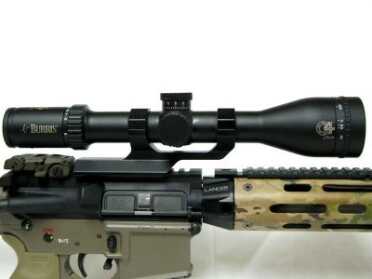
Burris C4Plus Right Profile – The 4.5-14X50 Burris C4Plus isn’t a large scope at just 13” long and weighing only 18 oz, it’s perfect for an AR platform or lightweight bolt action rifle. Possibly my one and only gripe is that when I received the scope the numbers on the power adjustment ring and adjustable objective were hard to read in anything but good light. To remedy that I took a white paint pen and filled in the numbers.
Burris Company
https://www.burrisoptics.com/
When I first got into shooting there wasn’t the wide variety of scopes and reticles to choose from that we enjoy today. While the elements that make up a riflescope haven’t changed in many years, the technology and features have changed and continue to do so. I believe that we’re now at a point where there is literally an optic for just about any shooting activity to meet just about anyone’s budget. Hunting scopes probably have the largest market share when it comes to the total number of optics sold, but they also have the fewest features to offer the shooter. The typical hunting scope is a pretty simple affair with covered turrets and a simple duplex reticle for aiming. For most shooters, this arrangement works well for those shots that don’t fall outside of 200 yards across the fields or in the backwoods. However if a shot has to be pushed past that distance, the only choices are to apply some Kentucky windage and hope you know the drop of the ammunition well enough or to attempt to close the gap.
This year, Burris released a new line of hunting scopes called C4Plus that provides options for shooters looking for more versatility from their optics in an affordable package. Featuring two popular variable magnification ranges, custom bullet drop compensating knobs, quality glass and a new reticle specifically designed for wind compensation, these scopes have the potential to reach past the hunting scope market. At first glance it appears that Burris has done its homework in the design and layout of these scopes, so lets take a closer look.
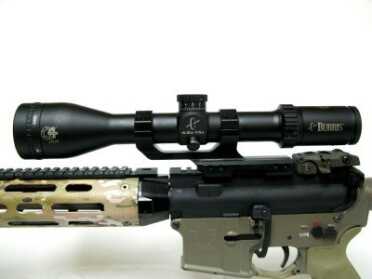
Burris C4Plus Left Profile – The Burris 4.5-14X42 felt at home on the AR-15 that I used for testing. Its generous eye relief mean that I didn’t have to crowd the stock to get a nice clear sight picture when I dropped down behind the rifle. That small nub that is protruding from the left side actually puts tension on the erector spring to ensure consistent, accurate adjustments. Although some people may feel the need to see if they can adjust it, it should never be messed with since it could permanently damage the scope.
The Burris C4Plus scopes have variable magnification with either a 3-9X or 4.5-14X magnification range and a 40mm or 42mm objective, respectively. Both magnification ranges are available with either a 1” or 30mm one-piece main tube for extra durability and strength. The scopes that have a 30mm tube get about 57% more internal travel than their 1” counterparts in the line. The 4.5-14X scopes feature parallax compensation in the form of an adjustable objective that has a range of 50 yards to infinity. The ability to adjust the parallax allows the target and the reticle to be brought onto the same focal plane to minimize errors due to an inconsistent cheek weld. It’s not stated at what distance the 3-9X scopes have their parallax set, to but I would imagine it would probably be at approximately 100 yards. All of the C4Plus scopes also have a European-style diopter adjustment that quickly and easily adjusts the focus of the reticle to the individual shooter’s eye. All of this is packed in to a pretty lightweight and compact package with the heaviest version weighing just 18 oz while the lower powered scopes are a scant 13 oz.
While it all sounds good so far, it doesn’t really set the C4Plus scopes apart from the many other hunting scopes that are already on the market. However, Burris has integrated features that are more akin to those found on long range optics and adopted a method for using the scope that’s common to practical precision rifle shooters. The first feature and the hallmark of the entire line up is the Cartridge Custom Calibrated Clicker, Burris’ term for a custom bullet drop compensating (BDC) knob. BDC knobs typically get a bad rap because whenever ammunition is used other than what the BDC was set up for, the accuracy of the calibration plummets.
To help create the most accurate system possible for the customer, Burris supplies a free BDC knob custom made for its ammunition and rifle. To obtain the BDC knob, the customer would have to go to Burris’ website and fill out a simple form with information such as type of ammunition, muzzle velocity, scope’s height over bore, etc… These are typical variables required when computing the ballistics of a cartridge and, as with any ballistic program, the more accurate the inputs the more accurate the data that’s returned. All the shooter needs to do is to obtain the range, such as with a laser rangefinder, and dial that distance onto the BDC knob. When properly set up, the custom BDC knob can take a lot of the guesswork out of deciding how much elevation to dial in for a long range shot.
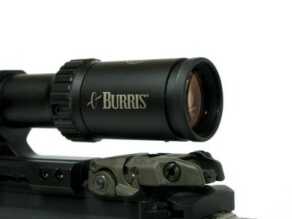
Burris C4Plus Diopter Adjustment – The Burris C4Plus scopes utilize a European-style fast focus eye piece to help get the reticle perfectly tuned to the shooter’s eye. This type of eye piece also works well with flip up scope caps since turning the magnification ring doesn’t affect the position of the cap.
The BDC knob only solves one part of the long-range shooting equation, though. Wind is the other part of the problem and is typically a shooter’s nemesis when trying to go the distance. The simple design of a duplex reticle works well as a basic aiming tool, but without any real reference marks, it does poorly when trying to compensate for wind. On the other hand some scopes that are used for long-range shooting have graduated reticles specifically designed to estimate range, compensate for the drop of a bullet, and/or hold for wind. Those characteristics are great for tactical shooting, but not all shooters want or need a such a reticle, as it may appear too busy to them or obscure too much of the target.
Burris bridges this gap nicely with its Wind MOA reticle by providing a functional design that isn’t too busy but can effectively deal with the wind at long range. With the C4Plus line, Burris essentially adopted the dial for elevation and hold for wind philosophy that is common with many tactical precision rifle shooters. Using this method the shooter dials in the elevation setting for a specific range on the BDC but only uses the Wind MOA reticle to compensate for the wind. This allows for fast and accurate corrections when dealing with wind conditions that can change rapidly, as they often do.
The Wind MOA reticle is designed with hashmarks every one minute of angle (MOA) extending out to 10 MOA on either side of the crosshair. There is also a one MOA hashmark above and below the crosshair for aiming reference and to make small adjustments in elevation without dialing. Just like with the BDC knob, to be supremely accurate the shooter must know the wind deflection for a particular bullet. With each custom BDC knob, Burris also includes a Wind Map using the same ballistic information to give the shooter accurate wind dope for a 10 mph cross wind. When the Wind Map is attached to the scope’s objective bell properly, it is within easy sight line of the shooter’s eye when looking down the side of the scope. The data on the Wind Map is in MOA, so it matches up perfectly to the reticle and corresponds to the number of hash marks over to hold on the target. This reticle, combined with the custom BDC knob, means that shooters can accurately engage targets at ranges they may have not considered doable before.
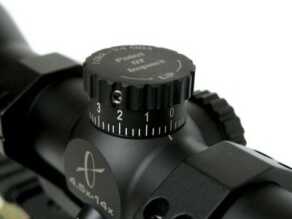
Burris C4Plus Elevation Turret Detail – The C4Plus scopes come with the shown ¼ MOA knob that can be used in lieu of the BDC knob or for zeroing just as you would any other scope. This knob, and the BDC knobs, actually slip down over a smaller turret and fasten to it with setscrews.
You can pack all of the features into a scope that you can possibly fit, but if it doesn’t perform on the range or in the field, then none of it matters. To put this scope through its paces, I headed back out to Peacemaker National Training Center in Glengary, West Virginia, to make use of its fantastic facilities. To complete my testing, I mounted the scope in a one-piece mount atop one of my AR-15 uppers, since the scope could just as easily find itself used to go after varmints or predators. For the majority of the testing, I used only match ammunition because ball ammunition on average is not consistent or accurate enough for long range use.
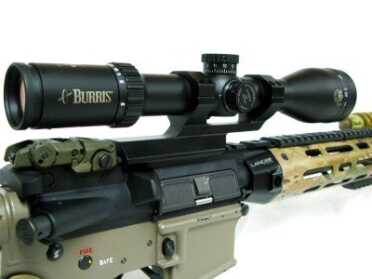
Burris C4Plus Windage Turret Exposed – In this picture you can see the exposed windage adjustment knob on the side that is normally covered up by a screw on cap. There is a similar knob underneath the pictured ¼ MOA elevation knob that can also be used for zeroing if the BDC knob is on the scope.
The scope was very easy to zero, and in no time at all I was punching the center of a Shoot-N-C target with Winchester 69gr Match ammunition. With a good, solid zero established, I decided it was time to see how well the scope tracked and ultimately returned to zero. In my opinion, the accuracy of a scope’s tracking is paramount to all of the other features, and I put its importance above even glass quality. My tracking test was pretty simple, but what I was looking for is that the adjustments that I dialed in equaled what I saw down range. First I dialed up 10 MOA using the 1/4 MOA knob that’s included with the scope and fired five rounds at a 3” Shoot-N-C. All five rounds made a nice ¾ MOA group in the center of the target. However, most scopes will track perfectly until you really start to stack on the adjustments, so I dialed another 10 MOA of elevation on top of that. Now with 20 MOA of elevation dialed in, I fired another five rounds at a Shoot-N-C that was placed above the first one. If there were any errors or faults in the system, they would most likely show up as the rounds impacting lower on the target due to lag in the adjustments. I had no such issues though, as all five rounds landed within an approximate 1” group about 20” above my point of aim, dead on as they say. I zipped the elevation turret back to my zero and turned it back up to 10 MOA, then down again before shooting my last group at 100 yards. There’s something to be said for the confidence one feels knowing that when you put the crosshairs on a target, that is where the bullet is going to go.
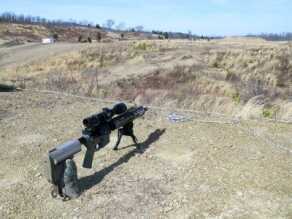
Burris C4Plus At 600 Yards – The 600 yard line at Peacemaker’s Patriot Range was no problem for the Burris C4Plus using Hornady 75grain Match ammunition. The combination of Wind MOA reticle and accurate adjustments meant that hits on the steel target were aplenty.
Satisfied with my zero at 100 yards, I moved out to the 200 and 300 yard steel targets on the Independence Range to try the 75 grain Hornady Match ammunition that I had with me. The ballistics of this ammunition is close to the Black Hills 77gr Match ammunition that I typically use, so I ended up using the same data for elevation and wind. Despite the stiff breeze going across the range, the Wind MOA reticle and the ammunition had no trouble hitting at both distances. The reticle performed exactly as it was designed to do also. Look at the wind data for a particular range, apply it to the reticle and shoot; it was as simple as that. The thickness of the stadia lines also contrasted nicely with the various backgrounds that I encountered, making it easy to pick up and index on target. Some reticles suffer from being too thin so they’re hard to pick up in low light or on darker backgrounds, but I do not believe that will be an issue with the Wind MOA reticle.
Something that I noted while shooting with the scope was that the parallax settings on the adjustable objective were pretty much dead on with the ranges I was shooting at. I feel that is a nod towards the quality of the scope, because typically most manufacturers will say that the numbers they put on parallax knobs are a guideline only. In fact, quite a few manufacturers won’t put numbers on there at all to try to mitigate complaints that the numbers don’t match up with the actual distances. It was refreshing to be able to set the parallax to 200 or 300 and have a crystal clear, parallax-free image at those ranges.
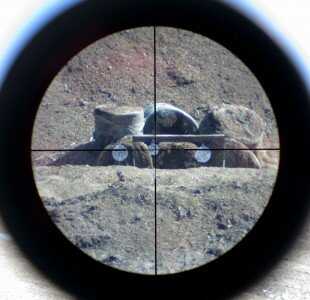
Burris C4Plus Wind MOA Reticle – This is a through the scope shot looking down range at Independence Range’s 300 yard steel targets. I would not judge the image quality of the Burris scopes based on this picture but the edge to edge clarity was very good. The reticle also contrasted well with the background making it and the hash marks easy to pick up and index on target. In this case, the picture imitates holding 1 MOA right on the center target to compensate for a stiff right to left wind.
I had had enough fun at Independence Range, so I saved the remaining 75 grain match ammo and went straight out to the 600-yard Patriot Range. Typically, Patriot Range utilizes sophisticated electronic targets, but this time only steel targets were available, which sometimes I prefer. The wind conditions at this range can be particularly tricky, and this occasion wasn’t any different. The wind started out fairly calm at a consistent 8-10 miles per hour but on occasion would gust to over 15 mph just long enough to screw up a shot. I tried the same Black Hills data that had worked well at the other range, so I dialed 17 MOA of elevation in the scope and held 7 ½ MOA left using the Wind MOA reticle. The image quality on this scope is very good and it made it easy to see what all was going on down range. I had no trouble seeing the mirage to help with wind calls or the splash of my bullet in the dirt when my first shot dropped just off the right edge. That was not a big deal, as I was able to make a quick hold-over correction using the reticle, and the very next shot hit steel. I won’t lie and say that every round of 75 grain Hornady Match hit steel, but a majority of them did, and the features of the C4Plus scope certainly made it look easy.
By the end of the day, I had shot roughly 200 hundred rounds using the Burris C4Plus, going all the way out to 600 yards in windy conditions, and I was pretty impressed. The reticle, the adjustments and the clarity of the glass gave me confidence that I could overcome the conditions and get hits on target. The innovative BDC system makes it well suited for use on a variety of rifles from the rimfire variety on up to magnums. Swap scopes, swap custom BDC knobs and you’re in business. The 4.5-14X model with a 30mm main tube is the most expensive in the line-up at $500, but when you consider the features that it has, the price isn’t that bad. Scope manufacturers are really stepping up their game this year, and I for one am excited to see what else Burris has to offer.
Ian Kenney is an avid firearms enthusiast and owner of ShootingVoodoo.com, a website dedicated to sharing information on multiple firearms topics.

Thank You this is a great article on the Burris C4 plus scope!! I just got a pretty high quality AR15 & will soon be getting a good quality scope for it . This scope sounds like what I have been looking for!! I already have other Burris scopes & I like them so this one looks good! I just got a 3X Burris red dot to work with,but the weather got to bad to be doing any shooting for fun until spring!!Thanks again & I will be looking at your website also..
200 * 200=40,000 rounds! A lot of shooting for one day!
“By the end of the day, I had shot roughly 200 hundred rounds”
don